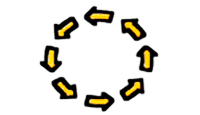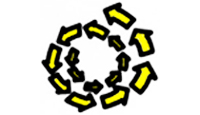
There are many different types of causal patterns in the world. Below are six patterns that are embedded in many science concepts and elsewhere in the world (Six Causal Patterns Sheet – PDF, 48KB). Causality in the real world seldom falls into one neat pattern or another. The patterns often work together or different parts of a system entail different patterns—making the causality even more complex!
Linear Causality
- Cause precedes effect; sequential pattern
- Direct link between cause and effect
- Has a clear beginning and a clear ending
- Effect can be traced back to one cause
- One cause and one effect; additional causes or effects turn this pattern into domino causality
Domino Causality
- Sequential unfolding of effects over time
- An extended linear pattern that results in direct and indirect effects
- Typically has a clear beginning and a clear ending
- Can be branching where there is more than one effect of a cause (and these may go on to have multiple effects and so on)
- Branching forms can be traced back to "stem" causes
- Anticipating outcomes involves deciding how far to trace effects. Short-sightedness can lead to unintended effects
Cyclic Causality
- One thing impacts another which in turn impacts the first thing (or alternatively impacts something else which then impacts something else and so on, but eventually impacts the first thing)
- Involves a repeating pattern
- May involve feedback loops
- May be sequential or may be simultaneous
- Typically no clear beginning or ending (Sometimes you can look back in time to a beginning but often that results in the classic "which came first, the chicken or the egg?" problem)
Spiraling Causality
- One thing impacts another which in turn impacts the first thing (or alternatively impacts something else which then impacts something else and so on, but eventually impacts the first thing) with amplification or de-amplification of effects
- Involves feedback loops
- It is sequential as each event is a reaction to the one before it
- Often a clear beginning and ending
- It is difficult to anticipate outcomes of later feedback loops during earlier feedback loops
Relational Causality
- Two things work in relation to each other to cause an outcome
- It often involves two variables in comparison to each other
- There may be a relationship of balance, equivalence, similarity or there may be a relationship of difference
- If one thing changes, so does the relationship, therefore so does the outcome
- If two things change but keep the same relationship, the outcome doesn't change
Mutual Causality
- Two things impact each other
- The impact can be positive for both, negative for both, or positive for one and negative for the other
- The causes and effects are often simultaneous, but can be sequential
- Typically one event, relationship, or process over time (such as the moss and algae in lichen) differentiating it from cyclic causality







